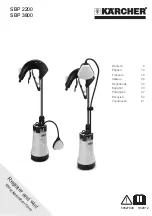
English |
17
You can also adjust the pendulum action during operation
using the pendulum action rotary switch
(5)
.
Level 0 (pendulum action switched off):
– For processing thin or hard materials, e.g. sheet metal,
steel
– For producing clean cutting edges
Level 1:
– For processing non-ferrous metals, hardwood, plastics or
materials of medium strength
Level 2:
– For processing non-ferrous metals, hardwood, plastics or
materials of medium strength
– For processing soft materials, e.g. lightweight materials,
insulation materials, softwood, other wood
Starting Operation
Switching on/off
To
switch on
the power tool, press the lock-off button
(8)
forwards first. Then press the on/off switch
(7)
and keep it
pressed.
The worklight lights up when the on/off switch
(7)
is lightly
or fully pressed allowing the work area to be illuminated in
poor lighting conditions.
To
switch off
the power tool, release the on/off switch
(7)
.
Note:
For safety reasons, the on/off switch
(7)
cannot be
locked; it must remain pressed during the entire operation.
Controlling/preselecting the stroke rate
You can variably adjust the stroke rate of the power tool
when it is on by pressing in the on/off switch
(7)
to varying
extents.
Applying light pressure to the on/off switch
(7)
results in a
low stroke rate. Applying increasing pressure to the switch
increases the stroke rate.
You can also preselect the stroke rate and change it during
operation using the stroke rate preselection thumbwheel
(6)
.
1:
Low stroke rate
6:
High stroke rate
The required stroke rate is dependent on the material and
the work conditions and can be determined using practical
tests.
It is recommended that you reduce the stroke rate when
placing the saw blade on the workpiece and when sawing
plastic and aluminium.
During prolonged periods of use at a low stroke rate, the
power tool may heat up significantly. Remove the saw blade
and let the power tool run at the maximum stroke rate for
around three minutes to cool down.
Constant Electronic control
The Constant Electronic control keeps the stroke rate at no
load and under load virtually consistent, guaranteeing uni-
form performance.
Working Advice
u
Remove the battery from the power tool before carry-
ing out work on the power tool (e.g. maintenance,
changing tool, etc.). The battery should also be re-
moved for transport and storage.
There is risk of injury
from unintentionally pressing the on/off switch.
u
Switch the power tool off immediately if the saw blade
becomes blocked.
Tips
u
When sawing lightweight materials, take into account
the statutory provisions and recommendations of the
material manufacturers.
Before sawing into wood, chipboard, building materials,
etc., check for any foreign objects such as nails, screws, etc.
and use a suitable saw blade.
Switch on the power tool and guide it towards the workpiece
you wish to work on. Place the base plate
(2)
on the surface
of the workpiece and saw through the material applying even
pressure and feed. Switch the power tool off once you have
finished your work.
Switch the power tool off immediately if the saw blade jams.
Widen the sawing gap slightly with a suitable tool and pull
the power tool out.
Swivelling and removable base plate (see figure C)
Thanks to its mobility, the base plate
(2)
adopts the required
angle position of the surface.
Depending on the application and the saw blade used, the
base plate
(2)
can be moved to three different settings
lengthwise.
Press the release button
(10)
and slide the base plate
(2)
into the required position. Release the release button and
check whether the base plate has securely clicked into
place. If required, slide the base plate until it securely clicks
into place.
To clean the saw blade receptacle
(14)
, you can also com-
pletely pull out the base plate
(2)
when the release button
(10)
is pressed. After cleaning, slide the base plate back into
its holder until it engages.
u
Do not press the release button during operation.
You
could lose control over the power tool and injure yourself.
Plunge cutting (see figure D)
u
Plunge cuts may only be applied to soft materials,
such as wood, gypsum board, etc. Do not plunge cut
metal materials.
u
Use only saw blades with a maximum length of
100 mm for plunge cutting.
When longer saw blades are
used, the base plate cannot be rested on the workpiece
and the power tool does not have the required hold.
Place the power tool so that the edge of the base plate
(2)
rests on the workpiece, without the saw blade
(1)
touching
the workpiece, and switch it on. When using power tools
with stroke rate control, select the maximum stroke rate.
Press the power tool firmly against the workpiece and allow
the saw blade to plunge slowly into the workpiece.
Bosch Power Tools
1 609 92A 81F | (21.07.2022)
Summary of Contents for GSA 18V-32 Professional
Page 3: ... 3 1 2 3 4 5 6 7 8 9 10 11 12 Bosch Power Tools 1 609 92A 81F 21 07 2022 ...
Page 4: ...4 A B C D E 13 1 14 3 2 10 4 F 1 609 92A 81F 21 07 2022 Bosch Power Tools ...
Page 234: ...234 1 609 92A 81F 21 07 2022 Bosch Power Tools ...
Page 238: ...IV 1 609 92A 81F 21 07 2022 Bosch Power Tools ...
















































